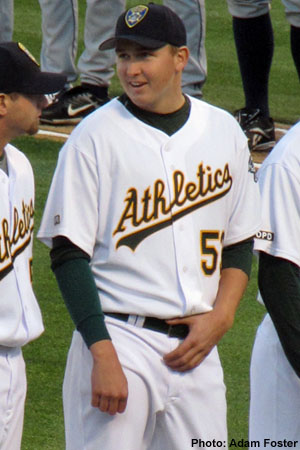
The following information was gathered from Trevor Cahill's April 7th and 12th starts against the Los Angeles Angels and Seattle Mariners, respectively. I charted Pitch-F/X data for both games then watched them on MLB.TV. Note that Pitch-F/X still doesn't get Trevor Cahill, frequently confusing his two-seam fastball with his changeup and misidentifying his breaking balls. I've attempted to correct these errors.
The Basics:
Pitch selection breakdown...
April 7th: 84.5% fastball, 5.8% slider, 4.9% changeup, 2.9% curveball
April 12th: 86.6% fastball, 10.3% changeup, 2.1% curveball, 1.0% slider
Fastball...His two-seamer sits in the 86-88 range; four-seamer 89-92. Cahill's average fastball was 88 MPH over the two games. But averaging his velocity is misleading, as he touches 84-93 with the pitch and occasionally throws it five different speeds in one at-bat. His two-seamer comes in with a lot of movement -- breaks away from lefties and into righties. Both fastballs jump out of his hand -- he hides them well -- which makes them appear faster than they actually are. Cahill's above-average ground-ball tendencies can be traced to his two-seamer. The pitch isn't, however, one that many batters swing through. Still, he gets enough late movement with his two-seamer to catch hitters off-guard and get them to take some strikes.
Changeup...Sits 77-80 and comes in at 79 MPH on average. Cahill frequently overthrows this pitch, propelling it into the dirt around home plate. While this makes the pitch almost unhittable, most hitters recognize that it's going to be a ball and hold up.
Slider...82-84 and 83 MPH on average. Note that part of the discrepancy between his slider usage on April 7th vs. 12th may be due to my judgment of the pitch. It basically spans the velocity ranges that his changeup and two-seam fastball don't tend to cover (80-83). This isn't a pitch that leaves hitters off-balance.
Curveball...78-80 and 79 MPH on average. Cahill rarely threw this pitch, and it was inconsistent when he did. But a few of his curveballs gave me cartoon eyes. Check out the one he struck out Ronny Cedeno with in the 6th inning on April 12th if you can. This pitch isn't sharp enough for Cahill to throw it regularly, but it's his strikeout pitch. Once he learns to throw is with more consistency, he'll increase his strikeout totals.
Box Score Breakdowns:
April 7th: 5.0 IP, 5 H, 3 R, 2 ER, 5 BB, 1 K, 0 HR (25 TBF, 7 GO/6 FO, and 57 strikes out of 103 pitches)
Cahill had trouble locating his two-seam fastball and changeup in this outing, leading to a high walk total. He was forced to frequently rely on his four-seam fastball, which comes in with next to no movement. Cahill threw three or more pitches to 20 of the 25 batters he faced -- five or more pitches to six batters. He did, however, keep the ball down in the zone well. Only two of the five hits he allowed went for extra bases -- Jeff Mathis double in the 2nd inning; Kendry Morales double in the 3rd.
April 12th: 7.0 IP, 2 H, 1 R, 1 ER, 3 BB, 3 K, 0 HR (25 TBF, 12 GO/6 FO, and 57 strikes out of 97 pitches)
He clearly had better command with his fastball this outing than in his big league debut. The lone extra-base-hit he allowed (double to Mike Sweeney in the 7th inning) was on a great piece of hitting -- he drove an 87 MPH two-seamer that was down in the zone. That said, I don't think Cahill was substantially better this outing than in his debut. He still didn't throw his curveball much, and his changeup was inconsistent. He's basically a fastball pitcher at this point in his career. Franklin Gutierrez aided Cahill's cause by grounding into first and third inning double plays to erase a pair of Endy Chavez walks. And I still don't think Seattle's Ichiro-less offense is very imposing -- they rank 28th in baseball in extra-base-hits so far this season.
Overall Opinion:
Cahill's sinker is a very good pitch. The movement he gets with it and his ability to throw it at so many different speeds are really what make him special. Velocities junkies should realize that even though his two-seamer probably won't reach the mid-90s often, he hides the ball well, which makes the pitch appear faster than it is. Cahill's curveball is a potential plus pitch. If he can harness it -- can be wicked at times -- then he'll blossom into a No. 1-2 starter. Until then, he's probably going to nibble his way through more than a few short outings, maintaining his hold on a big league rotation spot due to his ability to work down in the zone and lack of mistake pitches.
We plan to post Scouting Reports regularly this season. Adam Foster can be reached at adamf@projectprospect.com.
